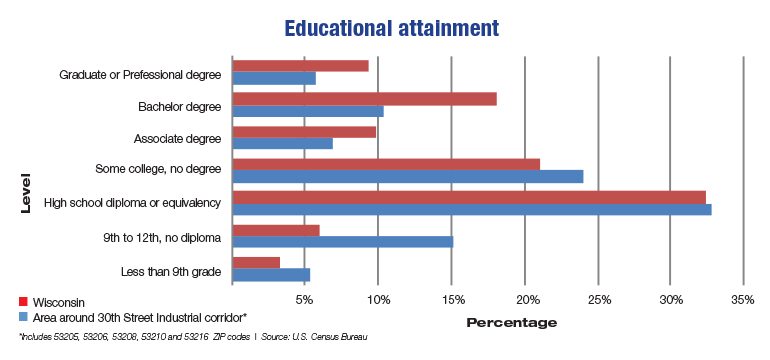As he talked through the efforts to connect the Milwaukee community to jobs, former Alderman Willie Wade made it a point to stress the relationship between his current employer, Employ Milwaukee, and Milwaukee Public Schools.
If more students are able to connect with the workforce, there will be fewer adults with barriers to employment later in life, said Wade, vice president of community relations at Employ Milwaukee.
If working with students before they face additional barriers to employment is part of solving Milwaukee’s inner city jobs puzzle, it is also a key part of filling the workforce needs of employers, many of whom have lamented their inability to find skilled workers.
Andy Hepburn, chief innovation officer at Butler-based GPS Education Partners, pointed out that in fields that go beyond entry level, there are two schools of thought for businesses. Some choose to engage and partner with their local chambers and schools; others feel it is entirely on high schools or technical colleges to prepare students.

Of those businesses that don’t engage, “I think that group that’s in that space is going to continue to struggle,” Hepburn said.
There was a time when a high school diploma alone was a ticket into the workforce, but over the years job requirements have trended toward postsecondary education. A 2013 Georgetown University report estimated 65 percent of the job openings available by 2020 would require some amount of education after high school.
That idea, combined with declining enrollment as the economy improved, prompted Milwaukee Area Technical College to launch its MATC Promise program in 2015. The program, targeted at low-income students, offers those who qualify an opportunity to attend school at no cost.
MATC Promise is a last-dollar scholarship program that covers the gap between what financial aid and a family can contribute and the total tuition. Vicki Martin, president of MATC, said the reality is many high school students won’t even consider the possibility of college because they think they can’t afford it.
The offer of the MATC Promise program was enough to attract 3,100 applicants in the first year, Martin said. A total of 1,200 actually registered for the program and in the end, fewer than 400 qualified. The program mandates on-time high school graduation from a high school within MATC’s district, a minimum score of 16 on the ACT, 90 percent attendance, a 2.0 grade point average during senior year of high school and attending MATC full-time.
Martin said the school learned in the first year that getting students and their families to complete the federal financial aid forms was among the most challenging aspects of the program. She said MATC plans to extend its work to reach younger students, hoping that over time more students will develop the expectation of going to college.
About 21 percent of MPS graduates surveyed in 2015 said they planned to go to a technical or vocational school after graduation, on par with statewide figures, according to data from the Wisconsin Department of Public Instruction. Roughly 36 percent of MPS graduates planned to go to a four-year school, compared with 52 percent statewide. About 14 percent of the Milwaukee students either had a job lined up after graduation or planned to seek employment. Statewide, that figure dropped to 8 percent.
Making sure MPS students graduate with a plan and the opportunity to have choices is a task that falls to John Hill, MPS’ director of college and career readiness. That means they have both the academic and the social and emotional foundation to be successful, he said.
Hill pointed out that for previous generations of students, there wasn’t a concerted effort by educators to expose them to all their career possibilities. Beginning next year, academic and career plans required by state law will have students developing a roadmap as early as sixth grade.
“The idea is that kids start at an early age,” Hill said.
The plans also help students match their interests and talents with potential career opportunities. They’re able to see salaries, recommended courses and degree requirements.
In the five zip codes surrounding the 30th Street Industrial Corridor, more than 20 percent of residents older than 25 do not have a high school diploma or equivalency, according to U.S. Census data. That’s more than double the percentage statewide.
The percentage of residents in that area that only have a high school diploma or equivalency is roughly the same, at about 33 percent, as statewide.
The percentage of individuals with college experience, including up to a graduate degree, is 58 percent statewide. For residents in the zip codes near the 30th Street Industrial Corridor, it’s closer to 47 percent.
Hill said he and his team are aware of the importance of their work.
“Our work can really have a positive impact on the city and the state,” he said.
The work is made more complicated by the fact that there are so many students to prepare.
“To me, that’s the biggest challenge that I wrestle with every day,” Hill said.
He also said partnerships with the business community make the work better, exposing students to potential careers. He highlighted members of the Metropolitan Milwaukee Association of Commerce Council of Small Business Executives welcoming tours for seventh graders. The program is in its third year, and the goal is to have every seventh grader tour a business in its fourth year.
The other program Hill pointed to was ProStart, a two-year culinary program that exposes students to professional chefs.
“It’s such a positive when we’re talking with them and they’re talking with us,” Hill said of the business community.


